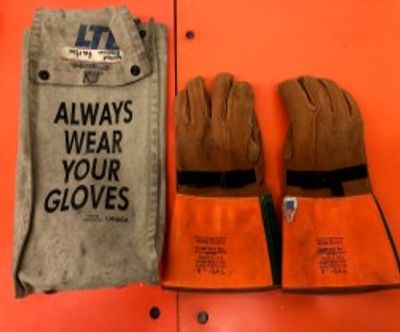Insulated Rubber Gloves & Sleeves
Relevant Standard ASTM F496 and ASTM F1236
Requires gloves to be electrically tested and visually inspected every 6 months.
Relevant Product Information
Insulated Rubber Gloves & Sleeves come in the following Classes 00, 0, 1, 2, 3, 4.
There are two types of rubber produced when making gloves and sleeves comprised of:
Type 1: nonresistant to ozone, made from high-grade rubber compound of natural or synthetic origin, properly vulcanized
Type 2: ozone resistant, made of any elastomer or combination of elastomeric compounds

Cleaning of Rubber Gloves & Sleeves
Glove/Sleeves are hand washed inside and out and then air dried.
Visual Inspection of Rubber Gloves & Sleeves
Gloves/Sleeves are inflated to inspect for cracking, ozone, UV damage, punctures, foreign objects.
When Inspecting Gloves to areas of the gloves are important to distinguish between. The working area of the gloves and Gauntlet area.
*Minor surface corona cutting or ozone in the gauntlet area, above the water line are not to be cause for rejection.
Electrical Test of Rubber Gloves & Sleeves
The electrical test is based on the classification of insulated rubber gloves.
Example: Recertification of class 0 gloves are tested at 5,000 volts AC for one minute. A pass for the electrical test is no flash over through the gloves or indication of high leakage.

Failure Modes for Gloves & Sleeves
Electrical Failure- glove is damaged by the high voltage test, typically a hole is produced by the failure and the electrical test is stopped.
Corona Cutting- cutting action of ozone on the rubber under stress. It manifests itself by sharp cuts in stressed areas. That are caused by a breakdown of rubber.
Ozone damage- can result of rubber protective equipment is stored near generators and in substations, especially if switching is done or arching occurs.
Natural Oxidization- slower than corona but still destructive if given sufficient time.
Ultraviolet damage- cracking and weakening of rubber overtime
Storage & Care of Gloves & Sleeves
Visual inspection Gloves/Sleeves are manually inflated to inspect for cracking, ozone, UV damage, punctures, foreign objects. (Before each use)
Glove liners are made to accommodate a range of hand sizes and absorb perspiration improving wearer comfort and dexterity
Leather protectors should always be worn over insulated gloves to provide needed mechanical protection against abrasion or cuts. Leather protectors should also be inspected for: tears, cuts, open seams, grease and oil, embedded wire or wood splinters. Protectors should be replaced when they no longer give adequate protection. Do not use protectors without rubber gloves.
Rubber gloves/sleeves should always be stored in glove bags or sleeve bags.
•Do not store more then one pair of gloves or sleeves in each bag
•Do not store on or in front of truck heaters. Not stored in area above 65 degree Celsius
•Do not roll, fold or tape
•Remove rubber gloves from protectors and store separated in glove bag.
Click link below for Information on our Glove Exchange Programs
Glove & Sleeve Programs
Glove & Sleeve Exchange Programs
Copyright © 2020 Western High Voltage Test Centre - All Rights Reserved.